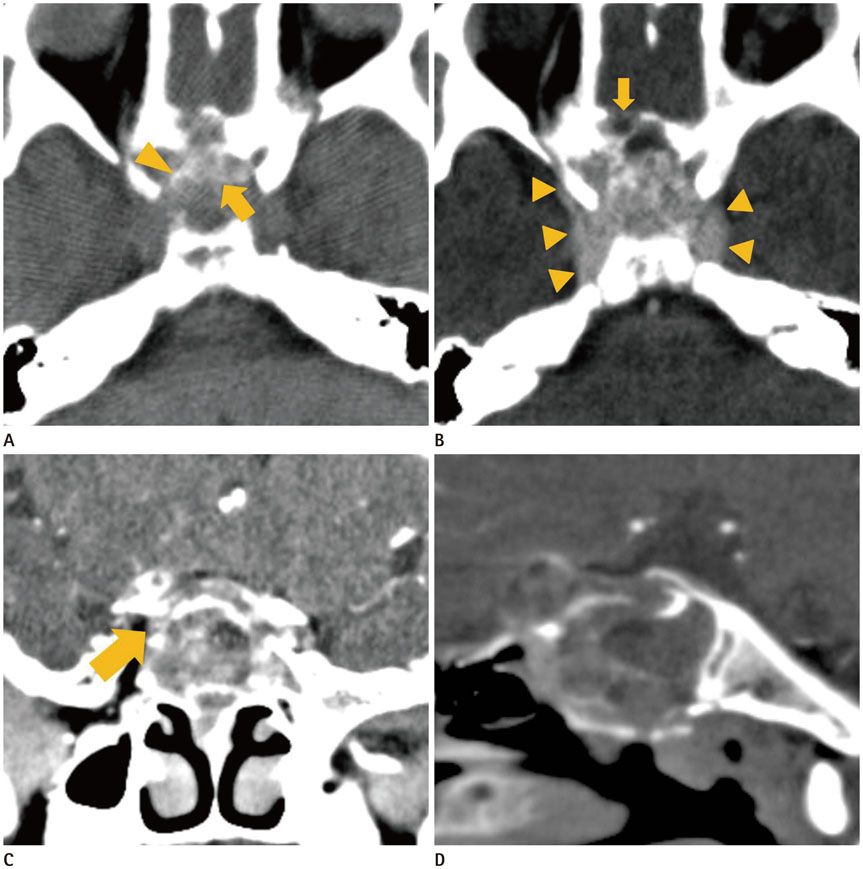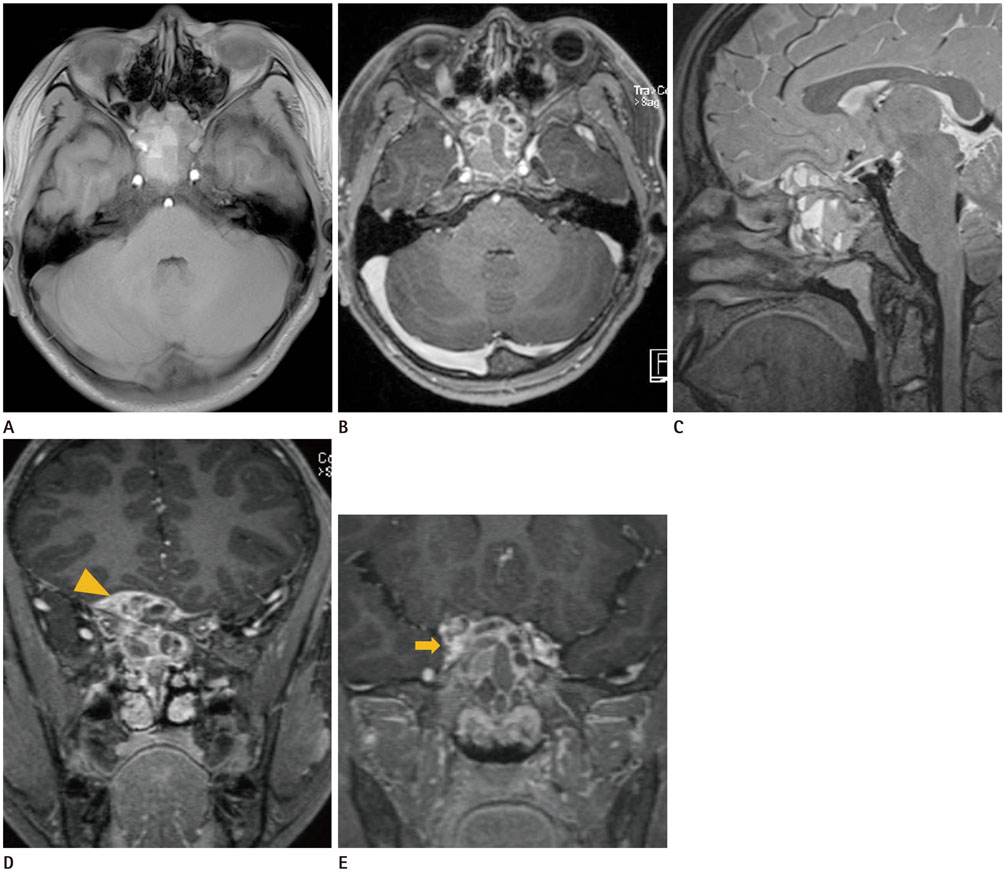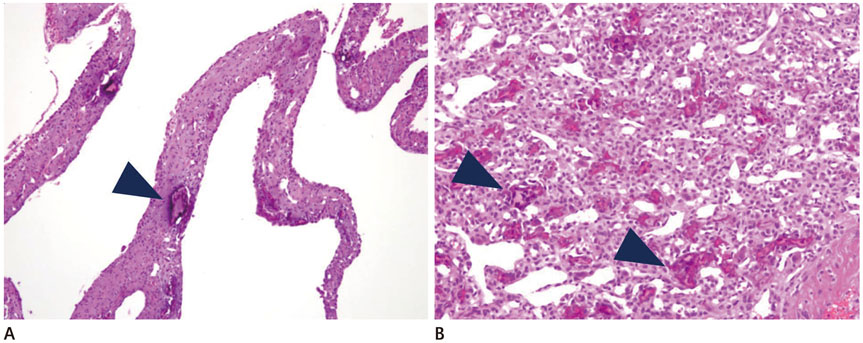J Korean Soc Radiol.
2017 Jan;76(1):61-66. 10.3348/jksr.2017.76.1.61.
Chondroblastoma with Secondary Aneurysmal Bone Cyst in the Sphenoid Sinus: A Case Report
- Affiliations
-
- 1Department of Radiology, Eulji University Hospital, Eulji University School of Medicine, Daejeon, Korea. midosyu@eulji.ac.kr
- 2Department of Neurosurgery, Eulji University Hospital, Eulji University School of Medicine, Daejeon, Korea.
- 3Department of Pathology, Eulji University Hospital, Eulji University School of Medicine, Daejeon, Korea.
- KMID: 2365053
- DOI: http://doi.org/10.3348/jksr.2017.76.1.61
Abstract
- Chondroblastomas are rare benign cartilaginous neoplasms found in young patients. These tumors typically arise in the epiphysis or apophysis of a long bone. Chondroblastomas arising in the skull and facial bones are extremely rare. We describe a rare case of a patient presenting with chondroblastoma with secondary aneurysmal bone cyst in the sphenoid sinus that mimicked invasive sinusitis or malignant bone tumor.
MeSH Terms
Figure
Reference
-
1. Stapleton CJ, Walcott BP, Linskey KR, Kahle KT, Nahed BV, Asaad WF. Temporal bone chondroblastoma with secondary aneurysmal bone cyst presenting as an intracranial mass with clinical seizure activity. J Clin Neurosci. 2011; 18:857–860.2. Kricun ME, Kricun R, Haskin ME. Chondroblastoma of the calcaneus: radiographic features with emphasis on location. AJR Am J Roentgenol. 1977; 128:613–616.3. Muntané A, Valls C, Angeles de Miquel MA, Pons LC. Chondroblastoma of the temporal bone: CT and MR appearance. AJNR Am J Neuroradiol. 1993; 14:70–71.4. Patrocínio TG, Patrocínio LG, de Castro SC, Souza AD, Patrocínio JA. Chondroblastoma of the sphenoid bone. Intl Arch Otorhinolaryngol. 2008; 12:579–581.5. Wang MJ, Zhou B. Chondroblastoma with secondary aneurysmal bone cyst in the anterior skull base. Interdiscip Neurosurg. 2016; 4:13–16.6. Erickson JK, Rosenthal DI, Zaleske DJ, Gebhardt MC, Cates JM. Primary treatment of chondroblastoma with percutaneous radio-frequency heat ablation: report of three cases. Radiology. 2001; 221:463–468.7. Brower AC, Moser RP, Kransdorf MJ. The frequency and diagnostic significance of periostitis in chondroblastoma. AJR Am J Roentgenol. 1990; 154:309–314.8. Weatherall PT, Maale GE, Mendelsohn DB, Sherry CS, Erdman WE, Pascoe HR. Chondroblastoma: classic and confusing appearance at MR imaging. Radiology. 1994; 190:467–474.9. Mankin HJ, Hornicek FJ, Ortiz-Cruz E, Villafuerte J, Gebhardt MC. Aneurysmal bone cyst: a review of 150 patients. J Clin Oncol. 2005; 23:6756–6762.10. Ramappa AJ, Lee FY, Tang P, Carlson JR, Gebhardt MC, Mankin HJ. Chondroblastoma of bone. J Bone Joint Surg Am. 2000; 82-A:1140–1145.
- Full Text Links
- Actions
-
Cited
- CITED
-
- Close
- Share
- Similar articles
-
- Chondroblastoma of the Talus Mimicking an Aneurysmal Bone Cyst: A Case Report
- Secondary Aneurysmal Bone Cystic Change of the Chondroblastoma, Mistaken for a Primary Aneurysmal Bone Cyst in the Patella
- Aneurysmal Bone Cyst in Clavicle: Report of A Case
- A Case of Aneurysmal Bone Cyst in the Skull Base
- Chondroblastoma of the patella: a case report




